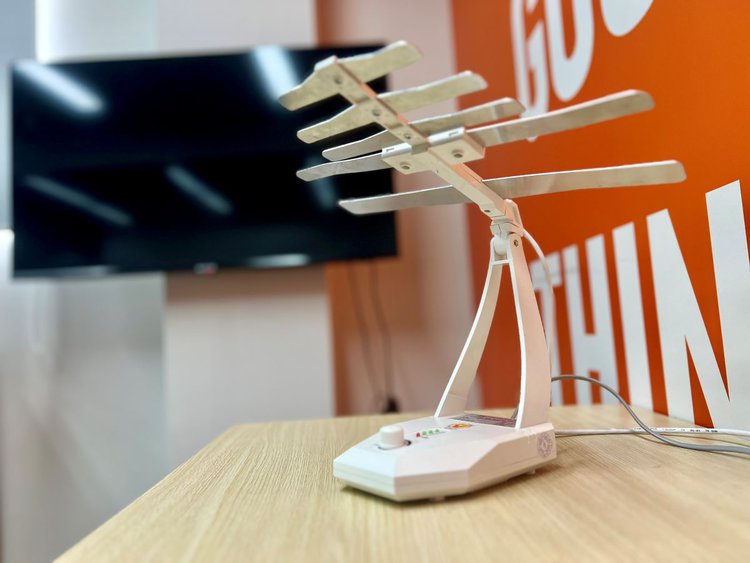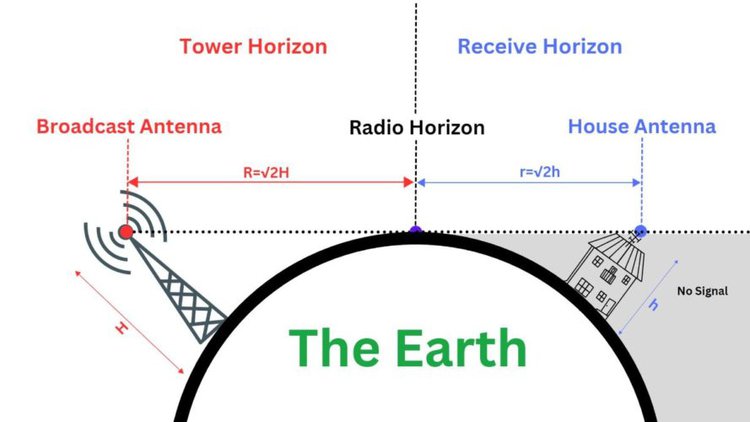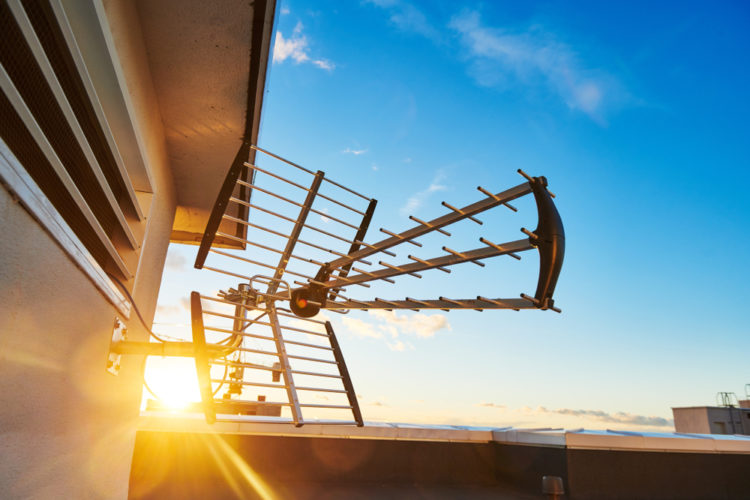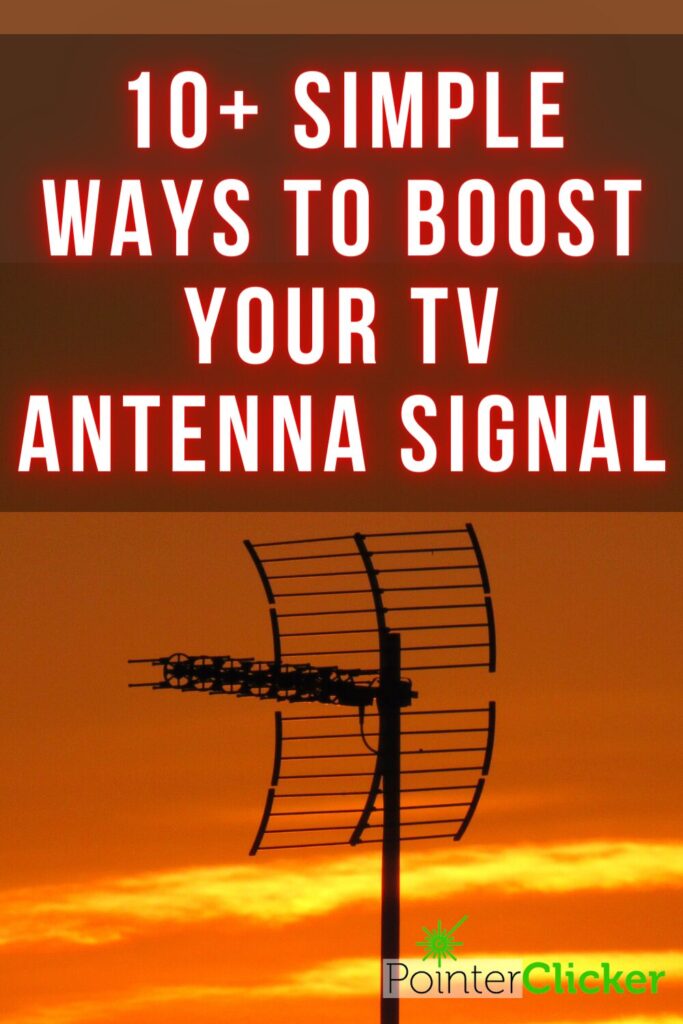10+ Simple Ways To Boost TV Antenna Signal Reception (Indoor & Outdoor)

- Boosting TV antenna signals involves adjustments like repositioning the antenna, ensuring a clear line of sight, using high-quality cables, and possibly installing a signal booster or distribution amplifier.
- Signal reception can be hindered by distance, height, obstacles, improper antenna type or installation, multiple connected TVs, and tuner sensitivity.
- For optimal signal reception, select the correct antenna type based on your location and transmitter direction, avoid physical obstructions, and limit the use of splitters by using an antenna per TV.
From poor installation to obstacles and antenna type, various factors can cause your antenna to have poor signal reception.
In this article, we’ll explore how to boost TV antenna signals for both antenna types. Keep reading!
Quick Navigation
Factors That Affect TV Signal Reception
Poor signal reception can occur at any time: during or after installation. You could be sitting—catching up on a favorite show—when your picture flickers off.

Poor signal reception can present as pixelation, white noise, a “No signal” message, or picture and audio distortion. Below are several factors that can affect signal reception for your TV antenna.
1. Distance
TV signals are broadcast from transmission towers, so you have to be within the transmission range of a transmitter to receive the signals from it. If your antenna is too far from a station transmitter, you will experience poor signal reception.
Analog TV signals fade gradually as they travel a distance. So, depending on your proximity to a station, you may receive high or low-quality TV signals.
On the other hand, digital TV signals do not fizzle out gradually. As long as no external factors act on the signals, they remain strong regardless of distance—until you get to the transmitter’s digital cliff.
The digital cliff is a distance beyond which signals from a digital transmitter will not travel. If you are beyond a transmitter’s digital cliff, your antenna will have little or no signal reception.
Since the move from analog to digital broadcasting in 2009, only a few analog TV stations still exist. Hence, your TV antenna is probably receiving digital broadcasts.
2. Height
In addition to distance, the height of your antenna also determines what signals it can receive. Picture your transmitting tower as an elevated point on the Earth’s curved surface. Signals travel horizontally from the station transmitter, in all directions.
After some distance, a traveling signal becomes tangent to the earth’s surface—this point is called the radio horizon. The tower’s height determines where the radio horizon occurs.

Signals travel past the horizon but not over it (i.e., they travel horizontally and do not bend along with the Earth’s curvature). If your antenna is not mounted high enough to reach the radio horizon, it will have no reception.
3. Ground-Level Obstacles
True to their name, TV broadcast signals travel over the air. Where there are obstacles (natural or man-made), the signals will be blocked from traveling further.
To get good TV signals, you need a clear line of sight between a transmitting tower and your antenna. If you own an outdoor TV antenna and still have poor reception, there may be obstacles between the antenna and the transmitting tower.
These obstacles include hills, trees, and large buildings (especially in urban areas). For indoor antennas, possible obstacles include concrete walls and metal furniture/architecture (i.e., roofing, windows, and doors).
4. Antenna Type/Installation
TV antennas come in different types. First, we can group them into two based on their place of installation; outdoor and indoor antennas. We can also group them into three based on their signal reception method: directional, multi-directional, and omnidirectional antennas.

If you are experiencing poor signal reception, you may be using your antenna the wrong way. Let’s consider the installation requirements for different antenna types.
- Directional antenna: This kind of antenna is most common for TV users. It receives broadcast signals only from one direction.
- Multi-directional antenna: This antenna receives signals from multiple directions.
- Omnidirectional antenna: Antennas in this category are relatively more expensive than their counterparts. They receive TV signals from all directions.
From the explanations above, you’ll see that multi and omnidirectional antennas do not have strict installation requirements. You just need to ensure they’re at an appropriate height and distance from transmitting towers, and you’ll have good signal reception.
Alternatively, you must point directional antennas toward your nearest (or preferred) transmission tower to receive clear signals. If you mount them facing a different direction, poor signal reception kicks in.
Because they receive signals from one direction, directional antennas typically have good reception, while omnidirectional antennas are prone to signal interference. Consider which station(s) you want to broadcast to your antenna, find their location(s), and choose an antenna type that fits your choice.
5. Number of Connected TVs
A typical antenna has a coaxial cable already attached to its RF connector. The other end of the cable plugs into the ANT IN port on your TV.
However, some people use a splitter to connect multiple TVs to a single antenna.
If you want your broadcast TV on multiple screens, your antenna should work fine with two TVs connected—anything more is asking for trouble.
When you split a TV signal, the signals experience insertion loss, which weakens them. The more times a signal is split, the weaker it becomes before reaching your TV. We recommend you use a maximum of two TVs with one antenna.
6. TV Tuner Sensitivity
A TV tuner is a device that receives TV signals from the antenna, decodes digital signals, and converts them to pictures and audio for the TV display. This tuner technology is built-in for most modern TVs. However, you can purchase an external TV tuner for your TV or monitor.
You must use a high-quality, sensitive tuner box. The more sensitive your TV tuner is, the better it will be at receiving and filtering TV broadcast signals.
Please, note that the coaxial cable running signals to your tuner or TV is very important. A low-quality coaxial cable can affect signal and picture quality.
Can Your TV Signals Be Blocked?
Yes, TV signals can be blocked or thrown off their intended path.
As mentioned earlier in the article, certain man-made or natural obstructions can block TV signals from reaching your antenna. However, physical obstacles are not the only cause for concern.
Below are other factors that block signals from reaching your TV:
1. A Disconnected TV Tuner:
If your tuner is disconnected from the TV or plugged into the wrong port, the screen will not display picture information from the signals.
2. Poor (Wet) Weather:
Moisture cuts off TV signals by reflecting or absorbing them.
3. Signal Interference From Power Lines:
High-voltage power lines cause electromagnetic interference due to the Corona Discharge. The EMI can interfere with radio waves, including TV broadcast signals.
4. Geography (Terrain):
Your geographical location may cause you to be out of the line of sight for nearby transmitters; this is especially true for people living in valleys.
How To Boost TV Antenna Signal Reception
In this section, we’ll cover the different things you can do to boost signal reception for your TV antenna.
For Indoor Antennas
- To prevent signal loss indoors, ensure there are few obstructions between the antenna and the signals coming from outside. For example, you can keep it near the non-metal window or in the attic (for height).
- Reposition the antenna to have a clear line of sight to the TV station transmitter.
- Ensure that your indoor antenna and coaxial cable do not have any physical issues (i.e., breaks, cuts, rust) that can affect their performance.
- Use a high-quality coaxial cable. Low-quality cables can weaken the signals your antenna is working hard to bring in, rendering them nearly useless when they hit your TV.
- Install a signal booster between your antenna and TV to strengthen signals from the antenna. TV signal boosters come in handy when your splitter or coaxial cable is causing signal loss.
- Use a distribution amplifier if you have multiple TVs. Splitters contribute to loss of signal quality, so if you must use one, use a distribution amplifier. We recommend the powered Antennas Direct Distribution Amplifier, which can distribute a single signal to multiple outputs without degradation.
- If you live in a suburb or far away from broadcast towers, switch from an indoor TV antenna to an outdoor or attic antenna. Outdoor antennas have a much wider pick-up radius.
For Outdoor Antennas
- Ensure your antenna is on the radio horizon. If it’s not, calculate the correct height your antenna needs to be to get the best signal. You can work out your calculations on TV Signal Factor – Radio Horizon.
- Choose an installation spot that is mostly clear of obstacles in the direction of the signal tower.
- Ensure your outdoor antenna and coaxial cable are not constantly exposed to harsh weather conditions.
- Use the correct type of antenna, depending on the location of your transmitter(s). You can also add a rotor to your directional antenna if you want to receive signals from multiple directions
- Instead of a splitter, get an antenna for each TV you own.

Conclusion
OTA broadcast TV is on the comeback, and many TV users struggle to find the best way to get in on it. While broadcast signals are mostly digital and strong, antenna reception is still quite tricky.
Your TV antenna can have poor reception even when signals are strong in your area. Poor reception and weak signals occur due to low-quality devices and cables, physical obstacles, interference, poor antenna installation, or signal splitters.
While indoor antennas are convenient and inexpensive, we recommend using an outdoor antenna to get more coverage. However, the tips in the article will help boost reception on any antenna type.
Gabriella ‘Diogo is a technical writer with a vested interest in tech hardware and equipment. She shares her knowledge and processes in an easy-to-grasp, lighthearted style. When she’s not testing or researching device performance, you’ll find her writing short stories or rewatching episodes of her favorite sitcoms.



